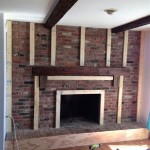Cultured Stone Veneer Fireplace: A Comprehensive Guide
A fireplace serves as a focal point in any living space, providing warmth, ambiance, and aesthetic appeal. The selection of materials for its construction or renovation significantly impacts its overall design and functionality. Cultured stone veneer has emerged as a popular choice for fireplace projects owing to its versatility, cost-effectiveness, and ease of installation.
Cultured stone veneer, also known as manufactured stone veneer, is a lightweight alternative to natural stone. It's crafted from a blend of Portland cement, aggregates, and iron oxide pigments, molded to replicate the appearance of natural stone formations. This manufacturing process allows for a wide range of textures, colors, and shapes, providing homeowners with extensive design options. This material’s synthetic composition contributes to its key characteristics that make it suitable for fireplace applications.
Unlike solid, natural stone, cultured stone veneer doesn't require structural reinforcement, making it a more straightforward and less expensive option for both new construction and remodeling projects. The veneer is applied as a surface finish over an existing structure, typically concrete, brick, or wood framing with appropriate backing materials. The result is the aesthetic of a traditional stone fireplace without the weight and cost burdens associated with it.
Aesthetic Versatility and Design Possibilities
Cultured stone veneer's greatest strength lies in its adaptability to various architectural styles. Whether the design calls for a rustic, traditional, or contemporary fireplace, cultured stone veneer offers a solution. The manufacturing process allows for the replication of different stone types, including fieldstone, river rock, stacked stone, and ledge stone. Each type presents a distinct visual texture and character, allowing homeowners to customize the appearance of their fireplace to match their preferences.
The diversity in color palettes is another significant advantage. Manufacturers offer a wide range of color options, from earthy browns and grays to brighter, more vibrant hues. This enables homeowners to coordinate the fireplace with the existing décor of the room. Custom color blends can also be created, allowing for a truly unique and personalized design. The pigments used in the manufacturing process are designed to resist fading, ensuring long-lasting color retention.
Furthermore, cultured stone veneer can be incorporated into various fireplace designs. It can be used to cover the entire fireplace surround, creating a dramatic focal point. Alternatively, it can be used as an accent material, highlighting specific areas such as the hearth or mantel. The flexibility of the material allows it to be used in both indoor and outdoor fireplace applications, extending the design options even further.
Cost-Effectiveness and Installation Advantages
Compared to natural stone, cultured stone veneer presents a more budget-friendly option. The manufacturing process is less labor-intensive and less resource-intensive than quarrying and transporting natural stone. This translates to lower material costs and reduced installation expenses. The lightweight nature of the material also contributes to lower transportation costs.
The installation process is relatively straightforward, especially compared to working with heavy natural stones. Cultured stone veneer is typically installed using a mortar adhesive applied to a prepared substrate. The individual stones are then carefully positioned and pressed into the mortar. While professional installation is recommended for optimal results, experienced DIY enthusiasts can also undertake the project with the right tools and techniques. The ease of installation translates to shorter project completion times and reduced labor costs.
The lightweight nature of cultured stone veneer reduces the need for structural modifications. In many cases, the existing fireplace structure can be used as a base for the veneer, eliminating the need for costly and time-consuming structural reinforcement. This is particularly beneficial in remodeling projects where minimizing disruption is a priority. The lighter weight also makes it easier to handle the material during installation, reducing the risk of injury and improving overall efficiency.
Proper preparation of the substrate is crucial for a successful installation. The surface should be clean, dry, and free of any loose debris. A scratch coat of mortar is typically applied to provide a textured surface for the veneer to adhere to. The mortar should be mixed according to the manufacturer's instructions and applied evenly to the substrate. This ensures a strong bond between the veneer and the underlying structure, preventing future issues such as cracking or detachment.
Durability, Maintenance, and Safety Considerations
Cultured stone veneer is designed to withstand the elements and maintain its appearance for many years. The material is resistant to fading, cracking, and spalling, making it suitable for both indoor and outdoor applications. However, it is important to note that cultured stone veneer is not completely impervious to damage. Exposure to harsh chemicals, excessive moisture, or impact can cause deterioration over time.
Regular maintenance is essential for preserving the appearance of a cultured stone veneer fireplace. This typically involves cleaning the surface with a mild detergent and water. A soft brush can be used to remove any dirt or debris that may accumulate in the crevices of the stone. Avoid using harsh chemicals or abrasive cleaners, as these can damage the surface of the veneer. Periodic sealing can also help protect the veneer from moisture and staining.
When using cultured stone veneer around a fireplace, safety is a paramount concern. It is crucial to adhere to local building codes and manufacturer's recommendations regarding clearances to combustible materials. The fireplace insert or firebox must be properly installed and vented to prevent the buildup of carbon monoxide. A non-combustible material, such as firebrick or cement board, should be used as a backing material behind the veneer in areas that are directly exposed to heat. These precautions are crucial for ensuring the safe operation of the fireplace and preventing fire hazards.
The type of mortar used for installation is also an important safety consideration. A high-temperature mortar should be used in areas that are exposed to direct heat. This type of mortar is designed to withstand extreme temperatures without cracking or deteriorating. Using the wrong type of mortar can compromise the structural integrity of the fireplace and increase the risk of fire.
Furthermore, it is essential to ensure that the cultured stone veneer is properly installed and maintained to prevent any potential hazards. Loose or detached stones can pose a tripping hazard or cause injury if they fall. Regular inspections should be conducted to identify and address any potential issues. Prompt repairs should be made to ensure the safety and longevity of the fireplace.
Cultured stone veneer provides an increasingly popular option for homeowners looking to enhance their fireplace with the look of natural stone. Its versatility, cost-effectiveness, and ease of installation make it an attractive alternative to natural stone. By carefully considering the design options, installation requirements, and safety precautions, homeowners can create a stunning and functional fireplace that adds value and character to their home.
The market offers a wide variety of cultured stone veneer products, each with its own unique characteristics. It is important to research different manufacturers and product lines to find the option that best suits the specific needs and preferences of the project. Consulting with a qualified contractor or designer can provide valuable guidance in selecting the right materials and ensuring a successful installation.
Choosing the right cultured stone veneer for a fireplace is a multifaceted decision that will depend on the homeowner's stylistic preferences, budget, and the specific requirements of the project. However, the benefits of cultured stone veneer, including its aesthetic versatility, cost-effectiveness, and ease of installation, make it a worthwhile choice for many fireplace projects.

Cultured Stone Veneer Fireplaces Main Street Fireplace Patchogue Serving Long Island Ny

Cultured Stone For A Unique Fireplace Royal Oak Mi Fireside Hearth

Thin Cut Stone Vs Cultured Veneer The Stoners

Cultured Stone Fireplaces The Stoners

Cultured Stone Manufactured Veneer Csi All Things Can En

Cultured Stone Winterhaven Pro Fit Alpine Ledgestone Residential Interior Living Room Modern Fireplace Project View Maritime Fireplaces

Interior Stone Fireplaces Walls Schut S

Inspiration Gallery Cultured Stone Stacked Fireplaces Wall Interior Design Walls

Cultured Stone Southern Ledgestone Fog From Offers A Rugg Outdoor Fireplace Manufactured Veneer House Backyard

Cultured Stone Veneer Ledgestone Mutualmaterials Com








